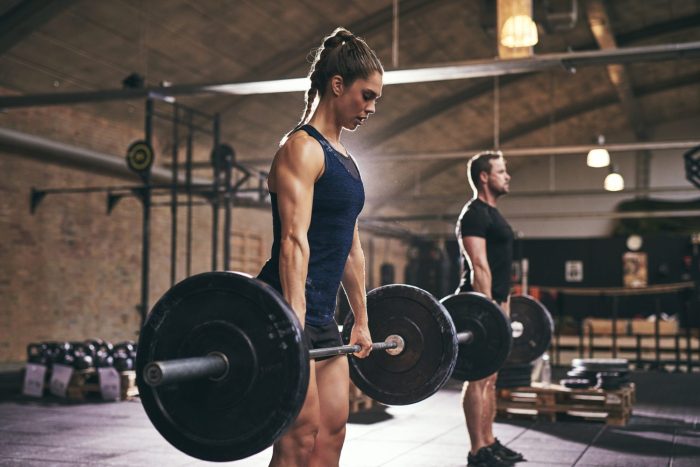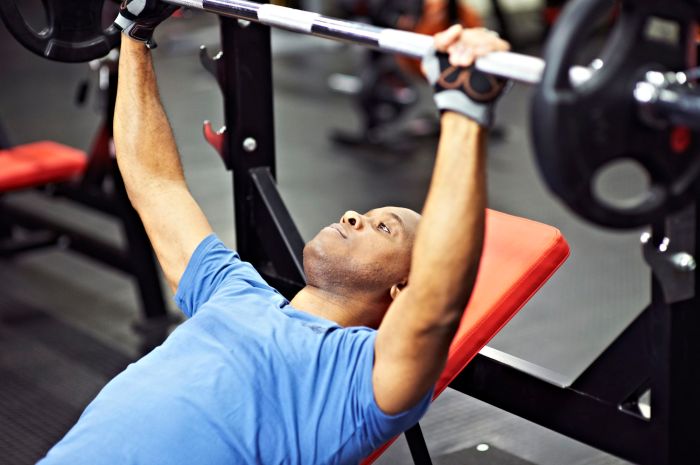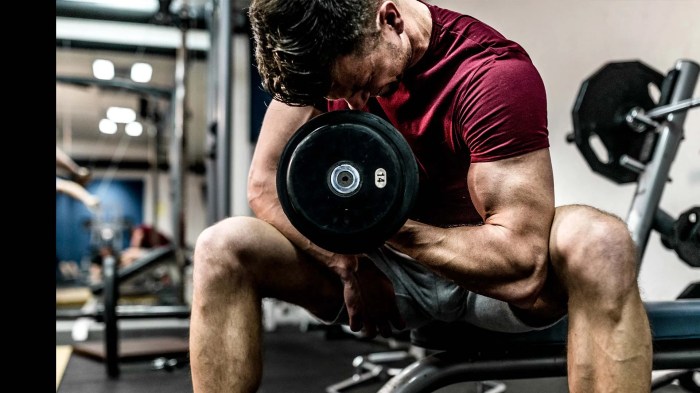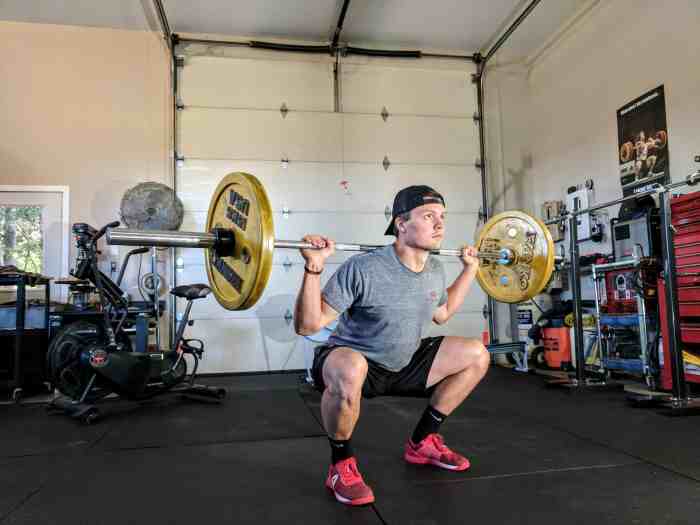Good weight lifting workouts are the key to building muscle, burning fat, and improving overall health. Whether you’re a beginner or an experienced lifter, this guide will provide you with everything you need to know to get started and achieve your fitness goals.
In this guide, we’ll cover everything from the basics of weight lifting to advanced techniques. We’ll also provide you with sample workouts, nutrition tips, and safety considerations. So whether you’re looking to get started with weight lifting or take your training to the next level, this guide has something for you.
Introduction
Weight lifting, also known as strength training or resistance training, is a crucial component of overall fitness and health. It involves using weights or resistance to build muscle strength and endurance. Regular weight lifting offers numerous benefits, including:
Muscle Building:Weight lifting stimulates muscle growth and development. It helps increase muscle mass, which is essential for strength, power, and overall physical performance.
Fat Burning:Weight lifting increases metabolism and helps burn calories, both during and after workouts. Building muscle through weight lifting also raises the body’s resting metabolic rate, leading to increased calorie expenditure even at rest.
Improved Bone Density:Weight lifting puts stress on bones, promoting bone growth and increasing bone density. This helps prevent osteoporosis and reduces the risk of fractures, especially in older adults.
Getting Started with Weight Lifting
To get started with weight lifting, follow these steps:
- Choose Appropriate Weights:Start with a weight that is challenging but allows you to maintain good form.
- Select Exercises:Choose exercises that target different muscle groups and work for your fitness level.
- Determine Frequency:Aim for 2-3 weight lifting sessions per week, allowing for rest and recovery.
Types of Weight Lifting Workouts
Weight lifting workouts can be categorized into different types, each with its specific purpose and benefits. The main types include strength training, hypertrophy training, and powerlifting.
Strength Training
Strength training focuses on increasing muscular strength, which is the ability to exert force against resistance. This type of workout involves lifting heavy weights for a low number of repetitions, typically 1-5 reps per set. Compound exercises, which work multiple muscle groups simultaneously, are often used in strength training.
Examples include squats, deadlifts, bench press, and overhead press.
Hypertrophy Training
Hypertrophy training aims to increase muscle size, or hypertrophy. It involves lifting moderate weights for a higher number of repetitions, typically 8-12 reps per set. Isolation exercises, which target specific muscle groups, are commonly used in hypertrophy training. Examples include bicep curls, tricep extensions, leg extensions, and calf raises.
Powerlifting
Powerlifting is a competitive sport that involves lifting maximal weights in three specific exercises: the squat, bench press, and deadlift. Powerlifting workouts focus on developing explosive strength and power, which is the ability to generate force quickly. The goal is to lift as much weight as possible in a single attempt.
Comparison of Weight Lifting Workouts
| Type | Goal | Benefits | Sets and Reps ||—|—|—|—|| Strength Training | Increase muscular strength | Improved strength, power, and athletic performance | 1-5 reps, 3-5 sets || Hypertrophy Training | Increase muscle size | Increased muscle mass, improved body composition | 8-12 reps, 3-5 sets || Powerlifting | Lift maximal weights in three specific exercises | Improved strength, power, and athletic performance | 1-3 reps, 1-3 sets |
Progressive Overload
Progressive overload is a fundamental principle in weight lifting that involves gradually increasing the stress on your muscles over time. This forces your body to adapt and grow stronger, leading to increased muscle mass and strength.
There are several methods to implement progressive overload, including:
- Increasing weight:Gradually add more weight to your exercises.
- Increasing sets:Do more sets of each exercise.
- Increasing reps:Do more repetitions of each exercise.
Progressive overload offers numerous benefits, such as:
- Increased strength:As you gradually increase the stress on your muscles, they become stronger to handle the load.
- Increased muscle growth:Progressive overload stimulates muscle protein synthesis, leading to muscle growth.
However, it’s important to note the potential risks associated with progressive overload, such as:
- Overtraining:Pushing yourself too hard without adequate rest can lead to overtraining and injuries.
- Muscle strains:Increasing weight or reps too quickly can strain muscles.
To mitigate these risks, it’s crucial to:
- Listen to your body:Rest when you need to and avoid overexertion.
- Progress gradually:Increase weight, sets, or reps slowly over time.
- Use proper form:Maintain good technique to minimize the risk of injuries.
Here’s an example of progressive overload in a weight lifting program:
- Week 1:Bench press with 100 lbs for 3 sets of 8 reps.
- Week 2:Bench press with 105 lbs for 3 sets of 8 reps.
- Week 3:Bench press with 110 lbs for 3 sets of 8 reps.
By gradually increasing the weight, you’re progressively overloading your muscles and stimulating growth and strength.
Exercise Selection

Selecting the right exercises is crucial for effective weight lifting workouts. Focus on compound exercises that engage multiple muscle groups simultaneously, maximizing efficiency and time spent in the gym. Isolation exercises, targeting specific muscle groups, complement compound exercises and help refine muscle development.
Compound Exercises
Compound exercises form the foundation of weight lifting workouts. They stimulate multiple muscle groups, leading to greater calorie expenditure and muscle activation. Examples include:
Barbell bench press
Chest, shoulders, triceps
Barbell row
Back, biceps
Overhead press
Shoulders, triceps
Barbell squat
Quads, hamstrings, glutes
Isolation Exercises
Isolation exercises target specific muscle groups, allowing for focused development and refinement. They are often used as supplementary exercises to compound exercises. Examples include:
Dumbbell flyes
Chest
Lat pulldown
Back
Lateral raise
Shoulders
Leg extension
Quadriceps
Bicep curl
Biceps
Progressive Overload
To continue progressing, gradually increase weight or resistance over time. This forces muscles to adapt and grow stronger. Monitor your progress and adjust the weight or resistance accordingly.
Accessory Exercises
Accessory exercises complement compound and isolation exercises by targeting specific muscle groups or movement patterns. They can enhance overall fitness and prevent muscle imbalances. Examples include:
Calf raises
Calves
Hamstring curls
Hamstrings
Glute bridges
Glutes
Core exercises
Abdominal and back muscles
Warm-up and Cool-down
Warm-up exercises prepare the body for weight lifting by increasing blood flow and muscle temperature. Cool-down exercises help reduce muscle soreness and promote recovery. Examples include:
Warm-up
Jumping jacks, light cardio, dynamic stretching
Cool-down
Static stretching, foam rolling
Rest and Recovery
Adequate rest and recovery are essential for muscle growth and repair. Allow sufficient time between workouts for muscles to rest and rebuild. Get enough sleep, hydrate well, and consider active recovery activities like yoga or swimming.
Workout Frequency and Duration

The optimal frequency and duration of weight lifting workouts depend on several factors, including your fitness level, goals, and recovery capacity. Here are some guidelines to help you determine the right schedule for you:
Fitness level:Beginners should start with 2-3 workouts per week, lasting 30-45 minutes each. As you get stronger, you can gradually increase the frequency and duration of your workouts.
Goals:If you’re looking to build muscle, you’ll need to lift weights more frequently and for longer durations than if you’re simply trying to maintain your strength. Aim for 3-5 workouts per week, lasting 45-60 minutes each.
Recovery capacity:It’s important to give your body adequate time to recover between workouts. If you’re feeling sore or fatigued, it’s best to take a rest day or reduce the intensity of your workout.
Factors to Consider
- Fitness level
- Goals
- Recovery capacity
- Lifestyle
- Time constraints
Rest and Recovery
Rest and recovery are crucial for weight lifting, as they allow your muscles to repair and grow stronger. Without adequate rest, your body will not be able to recover from the stress of weight lifting, and you may experience muscle soreness, fatigue, and decreased performance.
There are several key components to rest and recovery for weight lifters:
Sleep
Sleep is essential for muscle recovery. During sleep, your body releases hormones that promote muscle growth and repair. Aim for 7-9 hours of sleep per night to ensure your body has enough time to recover.
Nutrition
Nutrition is also important for muscle recovery. After a weight lifting workout, your muscles need protein to repair and rebuild. Aim to consume 1.6-2.2 grams of protein per kilogram of body weight per day.
| Optimal Sleep Duration | Protein Intake | |
|---|---|---|
| Adults | 7-9 hours | 1.6-2.2 grams per kilogram of body weight per day |
Active Recovery
Active recovery involves engaging in light physical activity on rest days. This helps to promote blood flow to your muscles, which can reduce muscle soreness and speed up recovery. Examples of active recovery activities include:
- Walking
- Cycling
- Swimming
- Yoga
Foam Rolling and Massage
Foam rolling and massage can also help to reduce muscle soreness. These techniques work by breaking up muscle knots and promoting blood flow. Foam rolling can be done at home using a foam roller, while massage can be performed by a massage therapist.
Warm-up and Cool-down

A proper warm-up before weight lifting workouts is essential for preparing your body for the intense activity. It helps to increase your body temperature, heart rate, and blood flow, which in turn improves your range of motion, flexibility, and strength.
A cool-down after your workout is equally important as it helps your body to recover and reduce muscle soreness.
Warm-up
A good warm-up routine should include both dynamic stretching and light cardio. Dynamic stretching involves moving your body through a range of motion, while light cardio helps to increase your heart rate and blood flow.
Dynamic Stretching
- Bodyweight squats
- Leg swings
- Arm circles
Light Cardio
- Jumping jacks
- Jogging in place
- Cycling
Cool-down
A cool-down routine should include static stretching and light cardio. Static stretching involves holding each stretch for 20-30 seconds, while light cardio helps to reduce your heart rate and blood flow.
Static Stretching
Hold each stretch for 20-30 seconds
Light Cardio
- Walking
- Swimming
- Yoga
Nutrition for Weight Lifting

Nutrition plays a crucial role in supporting weight lifting goals. A well-balanced diet provides the essential nutrients required for muscle growth, recovery, and optimal performance.The macronutrients protein, carbohydrates, and fats each have specific functions in the weight lifting process. Protein is the building block of muscle tissue, and consuming adequate amounts is essential for muscle growth and repair.
Carbohydrates provide energy during workouts and help replenish glycogen stores, which are essential for high-intensity exercise. Fats support hormone production, cell function, and provide energy.
Protein
Aim for 1.6-2.2 grams of protein per kilogram of body weight daily. Good protein sources include lean meats, poultry, fish, eggs, dairy products, and plant-based proteins like beans and lentils.
Carbohydrates
Consume 4-6 grams of carbohydrates per kilogram of body weight on training days and 2-3 grams on rest days. Whole grains, fruits, and vegetables are excellent carbohydrate sources.
Fats, Good weight lifting workouts
Include healthy fats in your diet, such as olive oil, avocados, nuts, and seeds. Aim for 1-1.2 grams of fat per kilogram of body weight daily.
Safety Considerations

Weight lifting can be an effective way to improve your fitness, but it’s important to do it safely. Here are some safety tips to keep in mind:
Use proper form and technique.This means lifting the weight with the correct posture and using the correct range of motion. Lifting with improper form can lead to injuries.
Use a spotter.A spotter is someone who can help you lift the weight if you need assistance. This is especially important for heavy lifts or exercises that you are not familiar with.
Monitor for pain.If you experience any pain while lifting weights, stop immediately and consult with a doctor. Pain is a sign that you may be injured.
Sample Weight Lifting Workouts: Good Weight Lifting Workouts
Here are some sample weight lifting workouts for different fitness levels and goals. These workouts are just a starting point, and you should adjust them to fit your individual needs and abilities.
When choosing exercises, focus on compound movements that work multiple muscle groups at once. This will help you save time and get the most out of your workouts.
Beginner Workouts
Beginner workouts should focus on building a foundation of strength and muscle mass. Start with a weight that is challenging but allows you to maintain good form. Aim for 8-12 repetitions of each exercise, and rest for 60-90 seconds between sets.
| Exercise | Sets | Reps | Rest | Target Muscle Groups |
|---|---|---|---|---|
| Barbell Squat | 3 | 10-12 | 90 seconds | Quads, hamstrings, glutes |
| Bench Press | 3 | 8-10 | 60 seconds | Chest, triceps, shoulders |
| Dumbbell Row | 3 | 10-12 | 90 seconds | Back, biceps |
| Overhead Press | 3 | 8-10 | 60 seconds | Shoulders, triceps |
| Leg Curl | 3 | 10-12 | 90 seconds | Hamstrings |
| Leg Extension | 3 | 10-12 | 60 seconds | Quads |
Intermediate Workouts
Intermediate workouts should challenge you more than beginner workouts. Increase the weight you are lifting, and aim for 6-10 repetitions of each exercise. Rest for 60-90 seconds between sets.
| Exercise | Sets | Reps | Rest | Target Muscle Groups |
|---|---|---|---|---|
| Barbell Squat | 3 | 8-10 | 90 seconds | Quads, hamstrings, glutes |
| Bench Press | 3 | 6-8 | 60 seconds | Chest, triceps, shoulders |
| Dumbbell Row | 3 | 8-10 | 90 seconds | Back, biceps |
| Overhead Press | 3 | 6-8 | 60 seconds | Shoulders, triceps |
| Leg Curl | 3 | 8-10 | 90 seconds | Hamstrings |
| Leg Extension | 3 | 8-10 | 60 seconds | Quads |
Advanced Workouts
Advanced workouts are designed for experienced lifters who are looking to push their limits. Use a weight that is challenging but allows you to maintain good form. Aim for 4-8 repetitions of each exercise, and rest for 90-120 seconds between sets.
| Exercise | Sets | Reps | Rest | Target Muscle Groups |
|---|---|---|---|---|
| Barbell Squat | 3 | 6-8 | 120 seconds | Quads, hamstrings, glutes |
| Bench Press | 3 | 4-6 | 90 seconds | Chest, triceps, shoulders |
| Dumbbell Row | 3 | 6-8 | 120 seconds | Back, biceps |
| Overhead Press | 3 | 4-6 | 90 seconds | Shoulders, triceps |
| Leg Curl | 3 | 6-8 | 120 seconds | Hamstrings |
| Leg Extension | 3 | 6-8 | 90 seconds | Quads |
Common Mistakes in Weight Lifting
Weight lifting is a fantastic way to improve your fitness, but it’s important to avoid common mistakes that can lead to injury or hinder your progress. Here are some of the most common mistakes to watch out for:
Overtraining
Overtraining is one of the most common mistakes made by weight lifters. It occurs when you push your body too hard, too often, without giving it enough time to recover. This can lead to a number of problems, including:
- Injury
- Burnout
- Decreased performance
To avoid overtraining, it’s important to listen to your body and take rest days when you need them. It’s also important to gradually increase the intensity and duration of your workouts over time, rather than trying to do too much too soon.
Neglecting Rest
Rest is just as important as exercise when it comes to weight lifting. When you rest, your body has time to repair itself and rebuild stronger. If you don’t get enough rest, you’re more likely to get injured and your progress will be slower.Aim for 7-8 hours of sleep per night, and take rest days between workouts.
On rest days, you can still do some light activity, such as walking or yoga, but avoid anything too strenuous.
Using Improper Form
Using improper form is another common mistake that can lead to injury. When you use improper form, you’re not only putting yourself at risk of injury, but you’re also not getting the most out of your workouts.To avoid using improper form, it’s important to learn how to perform each exercise correctly.
You can do this by watching videos, reading articles, or working with a personal trainer. Once you know how to perform an exercise correctly, make sure to focus on using good form every time you do it.
Weight Lifting for Specific Populations
Weight lifting offers numerous benefits for individuals of all ages and fitness levels. However, it is essential to consider modifications and precautions for specific populations, such as beginners, women, and older adults.
Beginners
Beginners should start with a well-structured program that focuses on proper form and technique. They should choose exercises that target major muscle groups and gradually increase the weight and intensity as they progress. It is crucial to prioritize rest and recovery to allow for muscle growth and repair.
Women
Women often have different hormonal profiles and body compositions than men, which may influence their weight lifting approach. They may benefit from exercises that target the glutes, hamstrings, and core. Additionally, women should pay attention to proper nutrition and hydration to support their training goals.
Older Adults
Older adults may need to adjust their weight lifting workouts to accommodate age-related changes in muscle mass, flexibility, and balance. They should prioritize exercises that improve functional movements and stability. It is also essential to listen to their bodies and rest when necessary.
Advanced Weight Lifting Techniques
Advanced weight lifting techniques are methods used to increase the intensity and effectiveness of workouts. They involve pushing the body beyond its normal limits, leading to greater muscle growth and strength gains. However, these techniques should be used with caution, as they can also increase the risk of injury.
Some of the most common advanced weight lifting techniques include:
Drop Sets
- Performing multiple sets of an exercise with decreasing weight.
- Helps to exhaust the muscles and promote muscle growth.
- Can be risky for beginners or those with injuries.
Supersets
- Performing two or more exercises in a row without rest.
- Increases the intensity of the workout and saves time.
- Can be challenging for beginners or those with limited endurance.
Forced Reps
- Having a spotter assist you with an extra repetition or two beyond what you can do on your own.
- Helps to overcome plateaus and build strength.
- Should be used sparingly and only by experienced lifters.
“Advanced weight lifting techniques can be a valuable tool for experienced lifters looking to take their workouts to the next level. However, it’s important to use these techniques with caution and under the guidance of a qualified trainer.”
Advanced weight lifting techniques can be incorporated into a workout routine by gradually increasing the intensity and volume of your workouts. It’s important to listen to your body and take rest days when needed. If you experience any pain or discomfort, stop the exercise and consult with a medical professional.
Mental Aspect of Weight Lifting

Weight lifting is not just a physical activity; it also involves a significant mental component. Understanding the mental challenges and benefits of weight lifting can help you stay motivated and overcome setbacks.
Mental Challenges
* Fear of failure:The fear of not being able to lift a certain weight or complete a workout can be daunting.
Self-doubt
Questioning your abilities or progress can hinder your motivation.
Comparison to others
Constantly comparing yourself to others can lead to feelings of inadequacy.
Mental Benefits
* Improved self-confidence:Overcoming challenges in the gym builds confidence in other areas of life.
Stress relief
Weight lifting can be a healthy outlet for releasing stress and tension.
Improved focus and concentration
The mental focus required for weight lifting can translate to other tasks.
Staying Motivated
* Set realistic goals:Start with achievable goals to avoid discouragement.
Find a workout buddy
Having someone to support and encourage you can boost motivation.
Track your progress
Seeing your progress can provide a sense of accomplishment and keep you motivated.
Reward yourself
Celebrate your successes, no matter how small.
Overcoming Setbacks
* Acknowledge your feelings:Allow yourself to feel discouraged, but don’t dwell on it.
Identify the cause
Determine what led to the setback and find ways to address it.
Focus on the process
Don’t get caught up in results. Enjoy the journey and the improvements along the way.
Seek support
Talk to your workout buddy, a coach, or a friend for encouragement.
Weight Lifting for Different Sports
Weight lifting offers significant benefits for athletes in various sports, including improved performance and reduced risk of injury.Weight lifting helps build muscle strength and power, which are crucial for sports that require explosive movements, such as football and basketball. By strengthening muscles, athletes can enhance their ability to accelerate, jump, and change direction quickly.
Additionally, weight lifting improves muscle endurance, enabling athletes to sustain high levels of performance throughout the game.
Football
In football, weight lifting is essential for developing strength, power, and explosiveness. Players benefit from exercises that target the legs, core, and upper body, such as squats, deadlifts, and bench press. These exercises help build the strength needed for tackling, blocking, and running.
Weight lifting also reduces the risk of injuries by strengthening muscles and connective tissues.
Basketball
Basketball players require a combination of strength, power, and agility. Weight lifting helps develop these attributes through exercises like squats, lunges, and plyometrics. These exercises improve leg strength and explosiveness, enabling players to jump higher, run faster, and change direction quickly.
Weight lifting also helps strengthen the core, which is essential for maintaining stability and balance during the game.
Running
Weight lifting can benefit runners by improving strength, endurance, and injury prevention. Exercises like squats, calf raises, and core exercises help strengthen muscles involved in running, such as the quadriceps, hamstrings, and glutes. This improves running efficiency and reduces the risk of common running injuries, such as shin splints and plantar fasciitis.
End of Discussion
Weight lifting is a powerful tool that can help you achieve your fitness goals. By following the tips in this guide, you can create a workout plan that is safe, effective, and enjoyable. So what are you waiting for? Get started today and see the amazing results that weight lifting can bring!
Helpful Answers
What are the benefits of weight lifting?
Weight lifting has many benefits, including building muscle, burning fat, improving bone density, and reducing the risk of chronic diseases.
How do I get started with weight lifting?
To get started with weight lifting, you should start with a light weight and gradually increase the weight as you get stronger. It is also important to focus on proper form to avoid injury.
What are some good exercises for beginners?
Some good exercises for beginners include the bench press, squat, deadlift, and overhead press.
How often should I lift weights?
Most experts recommend lifting weights 2-3 times per week.
What is progressive overload?
Progressive overload is a training principle that involves gradually increasing the weight or resistance over time. This helps to challenge your muscles and promote muscle growth.
Leave a Reply